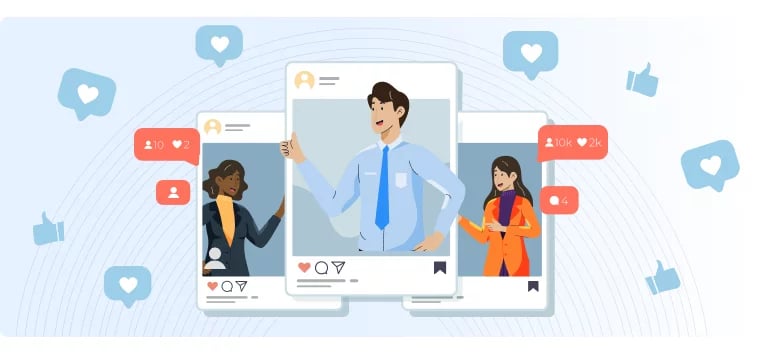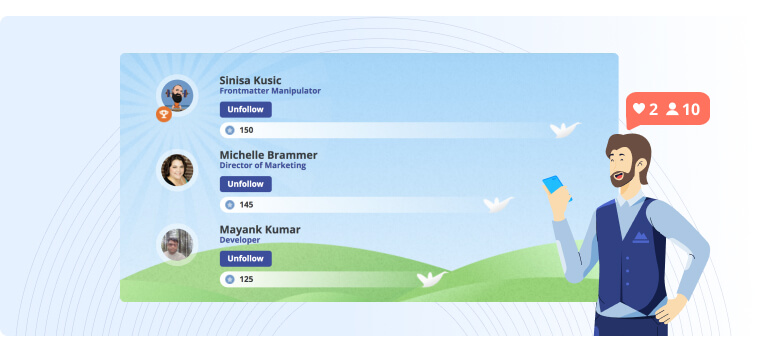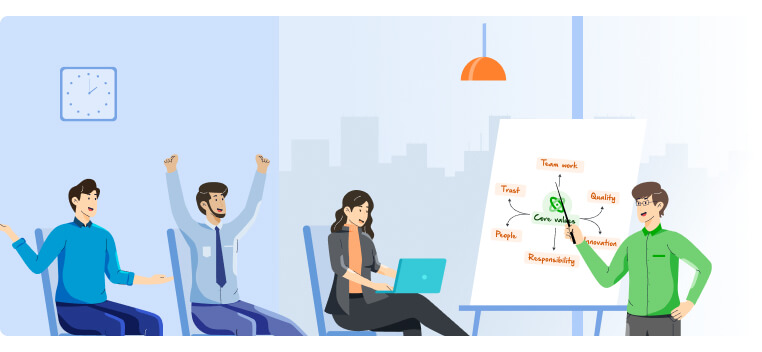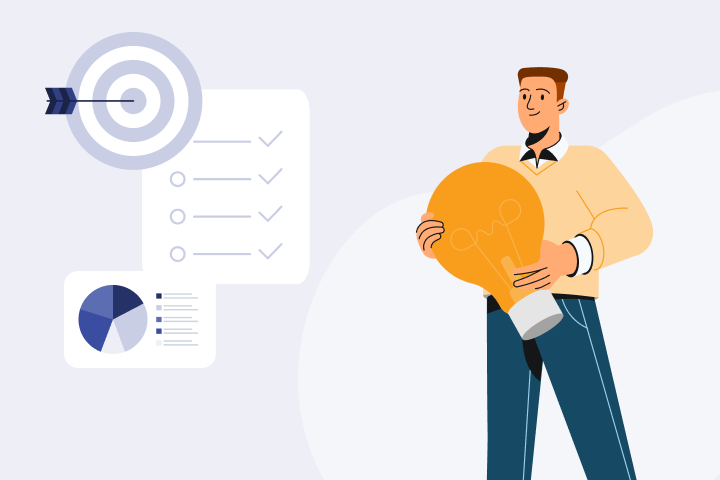Employee Brand Advocacy: The Superpower In Your Marketing Efforts
Getting your brand’s messages out there can be difficult, expensive, and look inauthentic, but leveraging your employees as brand advocates can change all of this in a big way.
People trust other people more than they trust brands, which is why when someone you know posts something on social media, you view it with a little more credence than you view an ad or a post from a brand handle. That’s why employee brand advocacy has become so important with the rise in employee advocacy. Everyone views ads with a level of skepticism because you know there’s an agenda behind them. But you don’t have that skepticism when you see posts from your friends.
That’s why using an employee advocacy program presents your message from a much more trustworthy source – your employees.
Employee advocacy is a great way to grow your organization’s social media presence organically. It’s a method that’s caught on and isn’t just a fad or a temporary trend. Many companies are either running or starting employee advocacy programs right now.
By 2023, 90% of B2B social media marketing strategies will incorporate scaled employee advocacy programs, according to Gartner.

Now, the idea of starting an employee advocacy program leads marketers to ask a lot of questions.
How does brand advocacy work?
How could I even convince employees to promote my brand on social networks?
And am I in a company culture where there’s enough employee engagement for an employee advocacy program?
Let’s answer all these questions and more to get a better sense of how your company is full of brand advocates, and how you can make them part of your marketing efforts.
The Benefits of Employee Brand Advocacy
A successful employee advocacy program makes your brand more personable. It shows the faces behind your logo.
When people in your organization promote your brand and its initiatives on social channels, it makes them look credible. And because they look credible, your brand does as well — they are the people who make up your brand after all.

People are more trustworthy to other people than a brand or ad is, meaning the messages people share resonate more than they would if your brand shared the same messages.
Social media posts from employees reach more than 5x further than posts from brands and get reshared 24x more frequently, according to the MSL Group.
When employees share content, it achieves a 200% higher click-through rate than when the company shares it, according to LinkedIn.

This should come as no surprise. People connect with people more than they do brands or ads, so posts from people will resonate more.
If you have employees organically share messages through your employee advocacy program on social media platforms, it gets your messages out there in a more trustworthy and authentic way, and it saves money on paid advertising.
You can greatly extend your brand’s reach by having employees engage with each other's posts, your brand’s posts, testimonial posts from customers, and more. You can also have employees share job postings, webinars, whitepapers, and other content to increase your traffic and conversions.
Once you have a group of dedicated employee brand advocates, you’re well on your way to a successful program.
Getting Employees To Buy-In To Your Marketing Efforts
If you want your employee advocacy strategy to take off, your employees need to buy in. The only way to get them on board is to convey to them what they get out of being a brand advocate.
So, what’s in it for the employees?
Well, there are many benefits of being part of a successful employee advocacy program. Your employee brand advocates will see their social media presence grow, and more engagement from their social posts. They’ll be viewed as thought leaders, look more credible in their industry, and attract more people who are in their target audience.
Many employee advocates see more opportunities including invites to speaking sessions. These could be conference speaker sessions, media interviews requests, and podcast invites.
When employees start to see more engagement on their social channels or see coworkers who are in employee advocacy programs get a larger social media presence, they’ll see the point of a successful employee advocacy strategy.
Incentivize Employees With Gamification
Another way to spur employees engagement and to buy in on your employee advocacy strategy is to implement gamification into your program.
Employees across your company might not see the point of getting involved in your marketing efforts, even if you explain to them the benefits of growing their social media presence. However, gamification is a great way to give your employees some incentive to be a part of your program. It also injects some friendly competition into your brand advocates.
With an employee advocacy platform like GaggleAMP, you can assign points to activities you request employees carry out. For example, if you want your employees to retweet a tweet, you can assign five points to that action. If you want your employees to comment on a LinkedIn post, or vote in an online poll, you can assign 10 points to that. You could assign any amount of points you want to any action and employees in your program will earn those points once completing the action.

Employees who earn the most points will show up on a leaderboard in your employee advocacy platform. Think of this as an internal scoreboard of how much individual brand advocates contribute to the program. Of course, employee advocacy needs to be completely voluntary for it to work, and you can’t force employees to contribute, or else it will not be an authentic action. That being said, giving employees an incentive to contribute will motivate them a little more.
Gamification combined with employee advocacy tends to be incredibly successful with sales teams. Salespeople are very competitive and like to show up at the top of scoreboards. They like to win and hit goals. Having them compete to be a top employee advocate is great for them, great for the organization, and it will attract potential employees who are not yet in your program.
Your program manager can award prizes to people who reach certain point totals, who come out on top of the leaderboard, and more. Prizes can include anything from company swag, gift cards, lunch with the CEO, monetary rewards, and more.
People like winning prizes and getting acknowledged. When potential employees who are not in your program see prizes and acknowledgment as part of your employee advocacy program, they’ll be more likely to join and engage.
Where To Start With Your Employee Advocacy Strategy
Getting your employee brand advocacy program started might seem daunting, but it’s not.
You have happy employees in your organization right now who have social media accounts. It’s often the case that employees are happy to talk about work on social media, but they refrain from doing so out of fear of saying something wrong. They’re worried they might say something off-brand or something the company wouldn’t condone even if what they want to post is appropriate.
In these instances, there are a couple of easy steps you can take that will get your program off to the races.
First, establish a social media policy that includes your employees. You want employees to know they are encouraged to talk and post on social media. Many large regulated companies are worried about employees posting something they shouldn’t on social media, but they need to trust their employees. You hired your employees for a reason. Trust that they know right from wrong.
Second, implement social media training for your employees. This way they’ll know your social media guidelines, and be more confident and comfortable with social media. They’ll know they’re encouraged to be active on social networks and they’ll be more likely to do it.
Third, find your program champions. Find your happy employees who are engaged and are either already talking about work on social media or are likely to do so. These are people who will be your initial brand advocates.

You know these employees are most likely to share your brand messages on social media platforms and take part in your marketing efforts, so enable them to do so. Guide them by giving content and messages to share, people to connect with on social media channels, and posts to engage with on social media.
When your initial brand advocates get going and start taking your suggested activities into action, you will notice the boost in social media KPIs that you’re looking for. You’ll be able to show what this program can do with just this initial group of employees, and explain to your organization what your program would look like with even more brand advocates in your employee advocacy program.
The initial champions of your program will be able to deliver testimonials to the rest of your organization, explain how your employee advocacy platform makes it easy to be a part of the program and the benefits of employee advocacy that they see firsthand.
Once you plant the initial seeds of your initial brand ambassadors who see the power of employee advocacy, then more employee advocates will follow and your program will grow.











